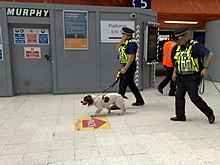

A detection dog or sniffer dog is a dog that is trained to use its senses to detect substances such as explosives, illegal drugs, wildlife scat, currency, blood, and contraband electronics such as illicit mobile phones.[1] The sense most used by detection dogs is smell. Hunting dogs that search for game, and search and rescue dogs that work to find missing humans are generally not considered detection dogs but fit instead under their own categories. There is some overlap, as in the case of cadaver dogs, trained to search for human remains.
A police dog is essentially a detection dog that is used as a resource for police in specific scenarios such as conducting drug raids, finding missing criminals, and locating stashed currency. Frequently, detection dogs are thought to be used for law enforcement purposes. Experts say that dog-sniff evidence should not be used in the criminal justice system, pointing to wrongful convictions, human biases that skew animal behavior, and the lack of systematic research into what dogs detect or how they do it.[2]
Although detection dogs are often used for law enforcement purposes, they are also used as a valuable research tool for wildlife biologists. In California, detection dogs are trained to discover quagga mussels on boats at public boat ramps because they are a harmful invasive species for the environment. Detection dogs also tend to be employed for the purposes of finding and collecting the feces of a diverse array of species, including caribou,[3] black-footed ferret, killer whale,[4] and Oregon spotted frog. This process is known as wildlife scat detection.
- ^ Jenkins, Austin (22 July 2009). "KPLU: Dogs Used to Sniff Out Cell Phones in NW Prisons". Publicbroadcasting.net. Archived from the original on 19 September 2012. Retrieved 11 November 2010.
- ^ "Should a dog's sniff be enough to convict a person of murder?". science.org. Retrieved 18 October 2021.
- ^ Wasser, Samuel K; Keim, Jonah L; Taper, Mark L; Lele, Subhash R (2011). "The influences of wolf predation, habitat loss, and human activity on caribou and moose in the Alberta oil sands". Frontiers in Ecology and the Environment. 9 (10): 546–51. Bibcode:2011FrEE....9..546W. doi:10.1890/100071.
- ^ Ayres, Katherine L.; Booth, Rebecca K.; Hempelmann, Jennifer A.; Koski, Kari L.; Emmons, Candice K.; Baird, Robin W.; Balcomb-Bartok, Kelley; Hanson, M. Bradley; Ford, Michael J.; Wasser, Samuel K. (2012). "Distinguishing the Impacts of Inadequate Prey and Vessel Traffic on an Endangered Killer Whale (Orcinus orca) Population". PLOS ONE. 7 (6): e36842. Bibcode:2012PLoSO...736842A. doi:10.1371/journal.pone.0036842. PMC 3368900. PMID 22701560.